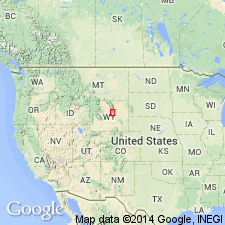
- Usage in publication:
-
- Otter Creek Sandstone Member
- Modifications:
-
- Named
- Dominant lithology:
-
- Sandstone
- AAPG geologic province:
-
- Bighorn basin
Summary:
Basal sandstone of Cloverly Formation named Otter Creek Sandstone Member for exposures in northeast part of sec 7 and northwest part of sec 8, T45N, R87W on Otter Creek, Washakie Co, WY. Can be recognized along southern Big Horn Mountains, Bighorn basin, WY. Is a ledge-forming unit that disconformably overlies Jurassic Morrison Formation. Underlies the mudstone member of Cloverly, a contact that is usually covered by soil or rubble. Is a white to gray, fine- to coarse-grained, cross-bedded, moderately to well-cemented sandstone that is locally yellow, orange, red, or brown, conglomeratic or shaly; 25-92 ft thick on western flank of Bighorn Mountains and 4-40 ft thick on the eastern flank of Bighorns. Is of marine and marginal marine origin. Correlates with lower part of: 1) Kootenai (central MT), 2) Lakota (Black Hills), 3) Lytle (Front Range, CO), 4) Cedar Mountain and Buckhorn (Colorado Plateau), and with Peterson Limestone and Bechler Conglomerate of Gannett Group (southeast ID-southwest WY). Of Early Cretaceous age. Correlation chart.
Source: GNU records (USGS DDS-6; Denver GNULEX).
For more information, please contact Nancy Stamm, Geologic Names Committee Secretary.
Asterisk (*) indicates published by U.S. Geological Survey authors.
"No current usage" (†) implies that a name has been abandoned or has fallen into disuse. Former usage and, if known, replacement name given in parentheses ( ).
Slash (/) indicates name conflicts with nomenclatural guidelines (CSN, 1933; ACSN, 1961, 1970; NACSN, 1983, 2005, 2021). May be explained within brackets ([ ]).

